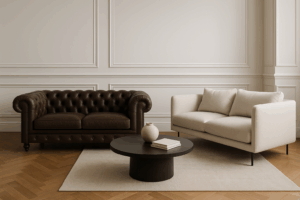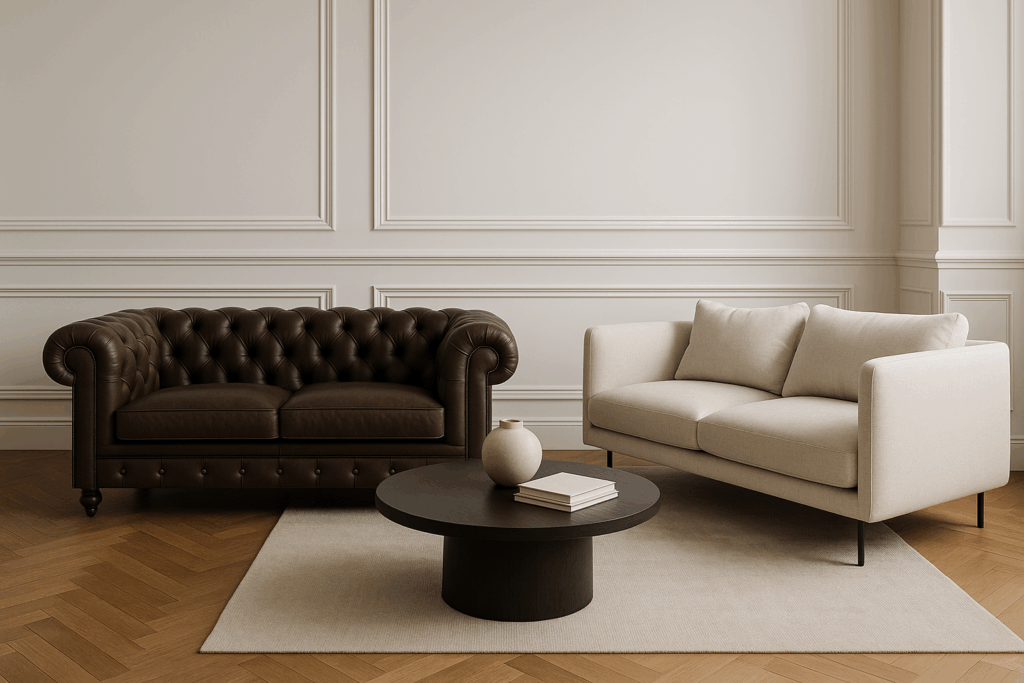Chesterfield Wiki
Official wiki of Chesterfield information
Chesterfield vs. Sofa: A Practical Guide to Choosing Your Centerpiece


Choosing the perfect sofa involves more than just comfort; it’s about selecting a piece that defines your space. For those drawn to timeless elegance, the Chesterfield sofa stands apart from regular sofas with its distinct heritage and design. This guide will explore the common mistakes people make when selecting a Chesterfield, helping you avoid costly errors and choose a piece that offers both classic sophistication and lasting value.
Contents
Ignoring Room Proportions and Scale
A common error is failing to account for the Chesterfield’s commanding presence. Its signature deep button tufting, rolled arms, and substantial frame require ample space to be appreciated fully. Placing a large, traditional Chesterfield in a small, minimalist room can overwhelm the space, making it feel cramped rather than cozy.
- Measure Twice, Buy Once: Always measure your room’s dimensions and the sofa’s footprint, including its depth and height.
- Consider Visual Weight: A leather Chesterfield has a heavier visual weight than a fabric one; choose accordingly based on your room’s existing elements.
- Example: For smaller spaces, consider a two-seater Chesterfield or one with slightly lower rolled arms to maintain proportion.
Prioritizing Price Over Craftsmanship
Opting for a cheap imitation is perhaps the most significant mistake. A genuine Chesterfield is an investment piece, built with a sturdy hardwood frame and premium upholstery designed to last for decades. Lower-priced alternatives often use inferior materials like particleboard and low-density foam, which sag and deteriorate quickly, losing the iconic silhouette and comfort.
- Check the Frame: Look for sofas constructed with kiln-dried hardwood, which resists warping and ensures longevity.
- Inspect the Tufting: Deep button tufting should be tight and secure, a sign of quality handcrafting that prevents the stuffing from shifting.
- Example: A well-made Chesterfield from a reputable source like Chesterfield Home is a decades-long investment, unlike a disposable fast-furniture item.
Misunderstanding Upholstery and Maintenance
Many buyers select an upholstery material based on aesthetics alone, without considering their lifestyle. For instance, a smooth, aniline leather Chesterfield in a household with pets or young children may lead to stress over scratches and stains. Conversely, choosing a delicate velvet for a high-traffic area without understanding the maintenance needs can result in rapid wear and tear.
- Match Material to Lifestyle: For families, consider a durable, pull-up leather or a performance fabric that hides wear. For formal settings, luxurious velvet or high-grade leather is ideal.
- Understand Care Requirements: Leather requires periodic conditioning, while certain fabrics may need professional cleaning. Factor this into your long-term decision.
- Example: Explore the range of durable options available in the Living Room collection to find a balance between beauty and practicality.
Conclusion
- Avoid the error of poor scale by meticulously measuring your space before purchasing a Chesterfield.
- Invest in quality craftsmanship over a low price tag to ensure your sofa remains a centerpiece for years.
- Select your upholstery material based on practical lifestyle needs, not just appearance.
- Proper, regular maintenance is non-negotiable for preserving the beauty and structure of your Chesterfield.
Read more at https://blog.chesterfield.com/category/chesterfield/what-is-the-difference-between-a-chesterfield-and-a-regular-sofa/
Explore Chesterfield Armchairs | Our Blog Sitemap | House of Chesterfield Sitemap | Powered by CCombox
